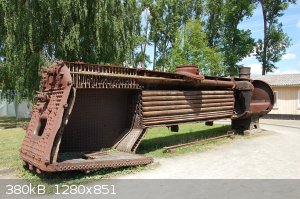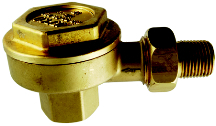RogueRose
International Hazard
    
Posts: 1585
Registered: 16-6-2014
Member Is Offline
|
|
Reclaimation of H2O from steam engine/turbine - phase change energy
One thing I never quite understood about steam engine and turbines is that many of them, especially in locomotives of old, didn't reclaim the water
which meant they needed to refuel at water depot's.
I was looking at some more "modern" steam powered generators and was wondering if, once the steam exits the turbine and is passing through the
exhaust, why not pass it up through a series of radiators (like those on an air conditioner, dehumidifier or even car/auto), having levels of X # of
radiators to provide enough cooling to convert back to water (so maybe angle them so that water drips down fins and collected at bottom of each
radiator).
This would do a number of things. The heat from the exhaust could heat incoming water before being sent to the heating chamber. The reclaimed water
would be warm/hot and could be fed into the radiators. There would be less need for new water to be added into the system if water supply is limited.
I would think that all of this would greatly increase efficiency as there is less energy needed to raise the water to BP and the amount of H2O saved.
I guess one of the main reasons it wasn't used for locomotives was b/c aluminum hadn't been invented and copper was pretty expensive (rarer at the
time) and machining wasn't as easy then. This doesn't explain why I haven't seen this implemented in more modern systems though.
|
|
|
XeonTheMGPony
International Hazard
    
Posts: 1636
Registered: 5-1-2016
Member Is Offline
Mood: No Mood
|
|
Look up closed cycle steam engines ( https://en.wikipedia.org/wiki/Condensing_steam_locomotive ) , there is a back pressure component that has to be factored in, but for most water is
cheap so why take the added cost of the heat rejection system into it?
Power plants how ever do use closed cycle, as purity of the water becomes an issue, so when using O2 scavengers and corrosion inhibitors using new
water would become very costly and since they are not burdened by weight or area putting in a large efficient condensing system is not an issue.
Now they did have exhaust heat scavengers, depending on the system they simply routed it through the water tanks outlet.
But like all things it is down to cost and for the most part people are short sighted and cheap never grasping by being cheap now they pay through the
nose over the operational life of the system!
[Edited on 5-12-2016 by XeonTheMGPony]
|
|
|
Fulmen
International Hazard
    
Posts: 1693
Registered: 24-9-2005
Member Is Offline
Mood: Bored
|
|
The condensers would both large and heavy, making them unsuited for locomotives. Instead they used the exhaust steam to increase air flow through the
firebox.
We're not banging rocks together here. We know how to put a man back together.
|
|
|
wg48
National Hazard
   
Posts: 821
Registered: 21-11-2015
Member Is Offline
Mood: No Mood
|
|
Here is pic of the heat exchanger used to boil the water in a locomotive.
The heat exchanger is the horizontal stacked tubes in the middle. A condenser would be of a similar size.

[Edited on 5-12-2016 by wg48]
|
|
|
XeonTheMGPony
International Hazard
    
Posts: 1636
Registered: 5-1-2016
Member Is Offline
Mood: No Mood
|
|
Quote: Originally posted by Fulmen  | | The condensers would both large and heavy, making them unsuited for locomotives. Instead they used the exhaust steam to increase air flow through the
firebox. |
Well for efficient ones yes but the ones they used where small so hence the penalty in efficiency when used on trains, I supplied a link explaining
the closed cycle steam engine on trains.
|
|
|
Morgan
International Hazard
    
Posts: 1660
Registered: 28-12-2010
Member Is Offline
Mood: No Mood
|
|
Some pulse furnaces condense exhaust gas for extra efficiency.
"The hot gases are forced through a series of tailpipes where condensing occurs extracting latent heat." (from a PDF file on the workings)
http://hpac.com/heating/hydronic-heating-system-helps-turn-e...
Popular Science Article
https://books.google.com/books?id=XARMtUUMxm8C&pg=PA47&a...
Primary and secondary schematic
https://www.energydepot.com/RPUcom/library/HVAC010.asp
[Edited on 5-12-2016 by Morgan]
|
|
|
Bert
Super Administrator
        
Posts: 2821
Registered: 12-3-2004
Member Is Offline
Mood: " I think we are all going to die. I think that love is an illusion. We are flawed, my darling".
|
|
I held a boiler operator's license at one point...
As noted by others, the penalty in weight and size of condensors/heat exchangers were an issue for mobile uses such as trains and tractors. (Nice
single pass fire tube locomotive boiler picture there, wg84... You should be glad you will never have to crawl inside an assembled one through that
little man hole on top, I damn near did not get back out, last time I had to.)
The penalty from increased corrosion, due to dissolved Oxygen and crapping up the boiler with scale from less than pure makeup water when running a
total loss system did lead to fixed power generating and ship borne closed systems, some thermal efficiency being gained as well. You can also use the
waste heat in the condensate to distill sea water, etc.
[Edited on 5-12-2016 by Bert]
Rapopart’s Rules for critical commentary:
1. Attempt to re-express your target’s position so clearly, vividly and fairly that your target says: “Thanks, I wish I’d thought of putting it
that way.”
2. List any points of agreement (especially if they are not matters of general or widespread agreement).
3. Mention anything you have learned from your target.
4. Only then are you permitted to say so much as a word of rebuttal or criticism.
Anatol Rapoport was a Russian-born American mathematical psychologist (1911-2007).
|
|
|
wg48
National Hazard
   
Posts: 821
Registered: 21-11-2015
Member Is Offline
Mood: No Mood
|
|
Bert: Well I would be happy to crawl in to one perhaps just once. I was a train spotter way back when steam was still common and you could wander
round rail yards without getting in too much trouble.
Yes its a great picture of a real cutaway model. The source is in the file info.
[Edited on 5-12-2016 by wg48]
|
|
|
Fulmen
International Hazard
    
Posts: 1693
Registered: 24-9-2005
Member Is Offline
Mood: Bored
|
|
Thanks for the link, Xenon. I wasn't aware they did that, even though it was only for special operation where the goal wasn't efficiency.
We're not banging rocks together here. We know how to put a man back together.
|
|
|
Chemetix
Hazard to Others
  
Posts: 375
Registered: 23-9-2016
Location: Oztrayleeyah
Member Is Offline
Mood: Wavering between lucidity and madness
|
|
For a closed cycle phase change engine you can't beat the simplicity of the Minto wheel. Wally Minto didn't invent it, but the name stuck.
https://en.wikipedia.org/wiki/Minto_wheel
|
|
|
XeonTheMGPony
International Hazard
    
Posts: 1636
Registered: 5-1-2016
Member Is Offline
Mood: No Mood
|
|
When I built a steam system I used the exhaust steam to help preheat the incoming cold water befor condensing it, helped a ton in efficiency needed
less fuel once the system was running.
Want to make another steam engine but will be a long time befor I have the gear to do so.
|
|
|
Bert
Super Administrator
        
Posts: 2821
Registered: 12-3-2004
Member Is Offline
Mood: " I think we are all going to die. I think that love is an illusion. We are flawed, my darling".
|
|
If anyone is playing with pressures less than 25 psi, I just found a couple dozen 1/2" thermostatic steam traps + some rebuild kits in my old stuff.
Keeps you from wasting steam in heating applications...
https://en.m.wikipedia.org/wiki/Steam_trap
https://www.statesupply.com/mepco/steam-trap/radiator

Rapopart’s Rules for critical commentary:
1. Attempt to re-express your target’s position so clearly, vividly and fairly that your target says: “Thanks, I wish I’d thought of putting it
that way.”
2. List any points of agreement (especially if they are not matters of general or widespread agreement).
3. Mention anything you have learned from your target.
4. Only then are you permitted to say so much as a word of rebuttal or criticism.
Anatol Rapoport was a Russian-born American mathematical psychologist (1911-2007).
|
|
|